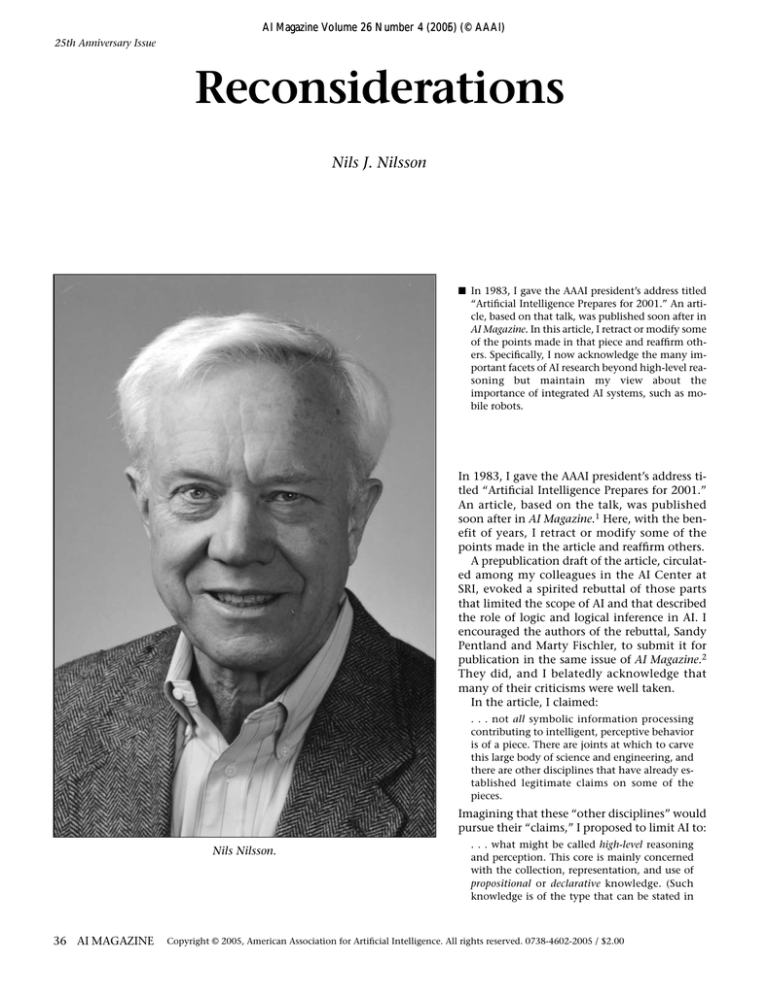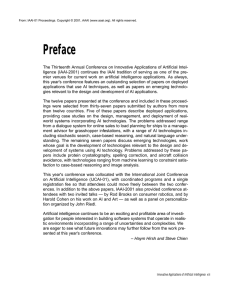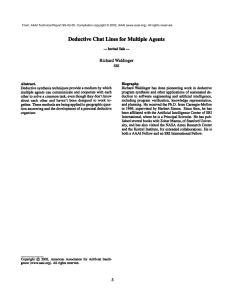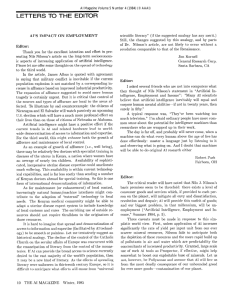
AI Magazine Volume 26 Number 4 (2005)
(2006) (© AAAI)
25th Anniversary Issue
Reconsiderations
Nils J. Nilsson
■ In 1983, I gave the AAAI president’s address titled
“Artificial Intelligence Prepares for 2001.” An article, based on that talk, was published soon after in
AI Magazine. In this article, I retract or modify some
of the points made in that piece and reaffirm others. Specifically, I now acknowledge the many important facets of AI research beyond high-level reasoning but maintain my view about the
importance of integrated AI systems, such as mobile robots.
In 1983, I gave the AAAI president’s address titled “Artificial Intelligence Prepares for 2001.”
An article, based on the talk, was published
soon after in AI Magazine.1 Here, with the benefit of years, I retract or modify some of the
points made in the article and reaffirm others.
A prepublication draft of the article, circulated among my colleagues in the AI Center at
SRI, evoked a spirited rebuttal of those parts
that limited the scope of AI and that described
the role of logic and logical inference in AI. I
encouraged the authors of the rebuttal, Sandy
Pentland and Marty Fischler, to submit it for
publication in the same issue of AI Magazine.2
They did, and I belatedly acknowledge that
many of their criticisms were well taken.
In the article, I claimed:
. . . not all symbolic information processing
contributing to intelligent, perceptive behavior
is of a piece. There are joints at which to carve
this large body of science and engineering, and
there are other disciplines that have already established legitimate claims on some of the
pieces.
Imagining that these “other disciplines” would
pursue their “claims,” I proposed to limit AI to:
Nils Nilsson.
36 AI MAGAZINE
. . . what might be called high-level reasoning
and perception. This core is mainly concerned
with the collection, representation, and use of
propositional or declarative knowledge. (Such
knowledge is of the type that can be stated in
Copyright © 2005, American Association for Artificial Intelligence. All rights reserved. 0738-4602-2005 / $2.00
25th Anniversary Issue
sentences of some form, as contrasted, say, with
knowledge that is implicit only in procedures or
in ad hoc data structures.)
Pentland and Fischler countered that:
AI research has already defined for itself a set of
“core topics”: the study of the computational
problems posed by the interrelated natural phenomena of reasoning, perception, language and
learning. These phenomena may, of course, be
viewed from many other vantage points including those of physics, physiology, psychology,
mathematics and computer science. AI has continued to survive as separate from these other
sciences because none of these other disciplines
focus on developing computational theories for
accomplishing intelligent behavior…. Their
central interests remain quite different.
Quite true! It was imprudent to try to limit
AI to just the high-level-reasoning part of intelligent behavior. AI has quite properly taken on
the whole job, which is just as well because
none of the other disciplines is doing it. “Human-level AI” (which I discuss elsewhere in this
issue) will require “reasoning, perception, language, and learning” and more. In fact, for the
past fifteen years or so I have been investigating
architectures3 and formalisms quite distinct
from high-level reasoning.
Even so, I still think that declarative representations (and manipulations of them) constitute an extremely important part of AI. There is
a need for intelligent agents to have and to be
able to use declarative knowledge in addition
to the “procedural knowledge” that is encoded
in special-purpose routines. Only those programs and circuits in which procedural knowledge is embedded can employ it. Declaratively
represented knowledge, on the other hand, can
be used for a wide variety of more general purposes—some of which might be unforeseen
when the knowledge is installed or otherwise
obtained. Also, in order to interact with humans at a high level of understanding, agents
will need to be able to respond appropriately to
declarative statements and commands—such
as “Rooms on the second floor can accept deliveries only on Tuesdays.” Additionally, we want
agents to be able to learn from books and other
declaratively expressed material.
I claimed in the article that declaratively represented knowledge should be represented “in
some sort of propositional, logic-like, formalism—and that much of the manipulation of
that knowledge can and should be performed
by mechanisms based on logical operations
and rules of inference.” Pentland and Fischler
quite appropriately objected to this version of
what I called “the propositional doctrine.”
Again with the benefit of years, I would now include many representational forms under the
heading “declarative knowledge.” Some examples are logical sentences, Bayes networks,
episodic memory, and case studies. I would also
include under the heading “reasoning,” many
kinds of computation over these forms (in addition to the standard logical rules of inference).
And nowadays, I wouldn’t necessarily place
reasoning at the “top” of an AI architecture—
communicating with “lower processes” through
procedural attachment. Perhaps the decision by
an agent to reason should itself be governed by
procedural mechanisms.
Pentland and Fischler complained that “…
AI research often concentrates on the formal
aspects of knowledge representations to the exclusion of how the representation’s symbols are
embedded in, and derive meaning from, the
world.” They say, “It is the embedding of a formal system in the world that gives meaning to
the system.” I agree. Whatever is represented
declaratively must be linked, ultimately
through sensors and effectors, to whatever
“world” the system behaves in. (Presumably,
much of what is represented procedurally is already so linked.)
Let me turn now to some points made in the
article that I take this opportunity to restate
and reaffirm.
I stated that it was far too early to agree with
the claim (often attributed to Marvin Minsky)
that intelligence is a kludge—too messy to
yield to “neat” theories about it. I still maintain
what I said then, namely:
As scientists and engineers, we should continue
to attempt to simplify, to organize, and to make
elegant models—otherwise there are serious
doubts that we would ever be able to understand enough about intelligence to design intelligent machines or to teach these design methods to students. If bridges had to be kludges, we
wouldn’t have a man-made bridge across the
Golden Gate because complex bridge-building
couldn’t be understood, taught, or remembered. Successful engineering requires the frictionless case and a succession of gradually more
complex models. I think AI has been reasonably
successful so far in inventing understandable
and useful theoretical frameworks and that it
would be inappropriate for us to discontinue
these attempts.
Related to the “intelligence-is-a-kludge” thesis is the tension between “neats” and “scruffies.” I still believe:
A dynamic field needs scruffies (informed but
not overly inhibited by neat theories) at its expanding frontier of knowledge, and it needs
neats to codify, clarify, and teach its core concepts. A field that is scruffy to the core has simply not yet matured as a science, and one that
does not have a scruffy exterior is simply sterile.
WINTER 2005 37
25th Anniversary Issue
portant. They could do anything that requires
moving around in and sensing a real environment and manipulating that environment in
some way. Aiming for roughly the same sort of
sensing and manipulative abilities that people
have would give us plenty of AI challenges.
In considering basic research projects of this
kind, it is important to avoid the trap of insisting that the project be directed at some specific
useful application. To attempt to justify robots
by proposing them as useful highway constructors, for example, is misguided because generalpurpose robots may be an inefficient way to
solve the road-building problem—or the transportation problem—or any other specific problem. Any single application of robots alone is
probably insufficient reason to justify their development. The whole reason for robots is their
general-purposeness!
Finally, as a conclusion to this note, I repeat
the introduction to the 1983 article:
Those of us engaged in artificial intelligence research have the historically unique privilege of
asking and answering the most profound scientific and engineering questions that people
have ever set for themselves—questions about
the nature of those processes that separate us
humans from the rest of the universe—namely
intelligence, reason, perception, self-awareness,
and language.
It is clear—to most of us in AI, at least—that our
field, perhaps together with molecular genetics,
will be society’s predominant scientific endeavor for the rest of this century and well into the
next . . .
Nilsson’s Original Address Appeared in this Issue of AI Magazine.
His presidential address was delivered on 11 August 1983 at the National Conference on Artificial Intelligence in Washington, D.C.
Near the end of the article, I made a suggestion that I think still has much to recommend
it:
A project should be initiated whose goal is to
develop a class of new AI programs that would
have a continuing existence. . . . let’s call them
computer individuals. The ground rule would be
that they should never be turned off . . .They
would have a constantly changing model of the
world and of the user(s). They should be able to
engage in extended dialogs in natural language.
Designing such programs would stimulate (in
fact force) research in machine learning because
it would be manifestly unintelligent for a computer individual existing over time not to benefit from its experiences….
We can think of several varieties of computer
individuals, including personal assistants,
meeting schedulers, expert consultants, and
mobile robots. . . . For the basic research purposes that such projects would serve, what specifically these robots would do is relatively unim-
38
AI MAGAZINE
Notes
1. Nilsson, N. J. 1983. Artificial Intelligence Prepares
for 2001. AI Magazine 4(4): 7–14, Winter, 1983
2. Pentland, A. P., and Fischler, M. A. 1983. A More
Rational View of Logic or Up Against the Wall, Logic
Imperialists! AI Magazine 4(4):15–18.
3. Nilsson, N. J. Teleo-Reactive Programs and the
Triple-Tower Architecture. Electronic Transactions on
Artificial Intelligence, 5 (2001), Section B: 99–110.
(Available from www.ep.liu.se/ej/etai/2001/006/.)
4. Nilsson, N. J., Teleo-Reactive Programs for Agent
Control, Journal of Artificial Intelligence Research, 1:
139–158, January 1994. (Available from www.cs.
washington.edu/research/jair/contents/v1.html/.)
Nils J. Nilsson is Kumagai Professor of Engineering,
Emeritus of Stanford University. He is the author or
coauthor of several AI textbooks and many of the
seminal papers in the field. His career in AI began at
SRI International in 1961 and continued at Stanford
University where he was the chair of the Department
of Computer Science from 1985 to 1990. Nilsson is a
Fellow and a past president of AAAI. He received the
IJCAI award for Research Excellence in 2003 and the
AAAI Distinguished Service award in 2005. He can be
reached at nilsson@cs.stanford.edu.






